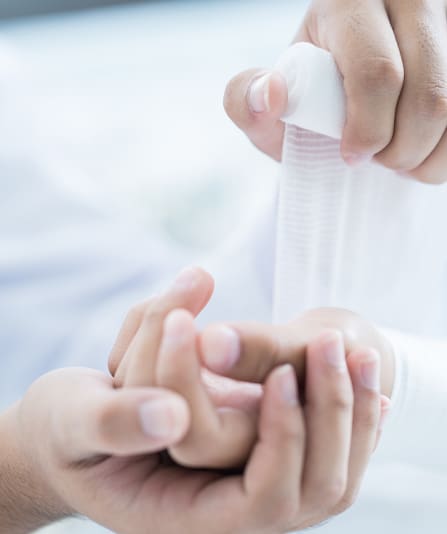Body & Face by Mr Ioannis Goutos
Wounds

A wound occurs when there is a break in the integrity of the skin secondary to an injury, infection or inflammation. Wounds can take a number of forms, including:
- Mechanical wounds caused by accidental injury such as a cut, skin tear or graze/abrasion, bite, surgical incision, or self-harm injury
- Burns or chemical injuries, which cause direct harm to the different layers within the skin
- Chronic wounds, such as ulcers or areas of skin infection that do not heal within 3 months
Normal skin has several important properties, including acting as a barrier to keep out infection and harmful substances and retain moisture. The skin also acts as a sensory organ; allowing us to feel the world around us through touch and temperature. When there is a break in the skin, there is opportunity for harmful microbes to get into the body and cause infection. Therefore, if one suffers a wound, it is important to carry out appropriate first aid. This includes cleaning the wound and applying an appropriate dressing until the skin is healed. In some instances, additional medical treatment may be required. For example, in wounds that are at high risk of infection, prophylactic antibiotics or tetanus immunisation are recommended.
Mr Ioannis Goutos is a London-based plastic surgeon with particular expertise in treating individuals who are suffering from burns and scarring. He has excellent experience and skill in looking after individuals with a wide range of problems and treatment goals. Mr Goutos provides thorough assessment, treatment (including both surgical and non-surgical procedures) and post-treatment care, with each treatment plan tailored to every individual.
Book your consultation today
Book nowAbout this condition
The skin has the ability to repair itself through a special healing mechanism which can be broken down into 4 distinct stages:
Stage 1: Haemostatic phase. This begins immediately following any injury to the skin. The body produces small blood clots which prevent excessive blood loss from the wound.
Stage 2: Inflammatory phase. Over the first to fifth day following injury, the immune system works to prevent infection in the wound and prepare the skin for the growth of healing tissue. Immune cells called white blood cells travel to the site of the wound to destroy any bacteria or harmful toxins and remove debris. Individuals may experience some pain, redness and swelling during this phase.
Stage 3: Proliferative phase. This is the stage of regeneration in the skin, where new skin cells, connective tissues and blood vessels are formed to repair the broken skin and restore tissue integrity.
Stage 4: Maturation phase. Once the skin cells have regenerated, there are additional connective tissues, such as collagen, that are remodelled to give the new skin strength and flexibility. This is when scar tissue is remodelled and can take up to 2 years to be fully completed.
There are a number of factors individual to each person that may affect their ability to heal following a wound, including age, medical background (in particular diabetes), medications, smoking status and nutrition.
In some instances, the process of scar formation can cause problems. For example, if there is too much or too little connective tissue laid down, or there is too much tension across the skin as it is healing, the resultant scar can be unsightly, uncomfortable and result in troublesome long term symptoms such as pain or itching. Problem scarring can occur in anyone but is more likely in those who have a family history of adverse scarring, experience complication during healing of the wound or have a connective tissue disorder, such as Ehlers-Danlos syndrome.
In order to promote good scar formation, there are a number of options that can be considered. This includes seeking appropriate medical attention in the event of significant wounds or concerns about wound infection. Keeping the wound clean and dry with the use of appropriate dressings in the initial phases, and then good moisturisation of the skin once the initial healing is complete can help to produce a favourable scar.
In the event of problem scarring, there are a number of treatment options available, including silicone/steroid tapes, needling, laser therapies and surgical options. The most appropriate treatment plan will depend on the individuals initial wound, scarring, symptoms and skin type.

Testimonials
Mr Goutos is delighted to share some of his patient and peer feedback on their experiences of his services.










